

Samsung’s structured & insightful business evaluation
Isabelle Taylor | 31 Aug,2021
Introduction
The main aim of this report is to evaluate the market position and strategic performance of the Samsung Group. In this report, you will get the opportunity to analyze the external and internal market conditions of Samsung as various market and business analysis tools have been implemented. Not just this, the competitive analysis will provide you with insight into the competitive positioning of Samsung in the global electronics market. The end section of this report includes pragmatic recommendations for Samsung which define the strategies that can be adopted by the company to establish a strong competitive position in the market.
Samsung company profile
Samsung is one of the largest manufacturers of electronics devices. The company specializes in the production of various electronic devices such as appliances, semiconductors, digital media services, memory chips, etc.
Samsung is a South Korean multinational company that was founded in 1938 as a trading company. It is a manufacturing conglomerate with its headquarters in Samsung Town, Seoul, South Korea. The business was started with the trading of noodles and other goods but in the late 1960s, it entered into the electronic industry. Further, during the 1970s, Samsung started exporting various electronic products in the overseas market. The late 1970s and 1980s mark rapid expansion of Samsung’s technology business.
Samsung also started to invest heavily in various research and development activities to push the company to the front end of the global electronics industry. Further, Samsung data systems were also established in 1985 to serve the growing business need for the system. In 1990, the company started to expand globally by globalizing various activities and electronics items such as mobile phones and semiconductors.
In 2008, Samsung launched the Samsung Galaxy smartphone series and since 2006, Samsung has been recognized as the top-selling Global brand for television. In 2010, the company announced the 10-year strategy of increasing its business and achieving a leading position in the global electronics market. In 2015, the company also granted more US patents than any other company and received around 7679 utility patents. Also, the world's latest mobile manufacturing facility was established in 2018 in Noida, India.
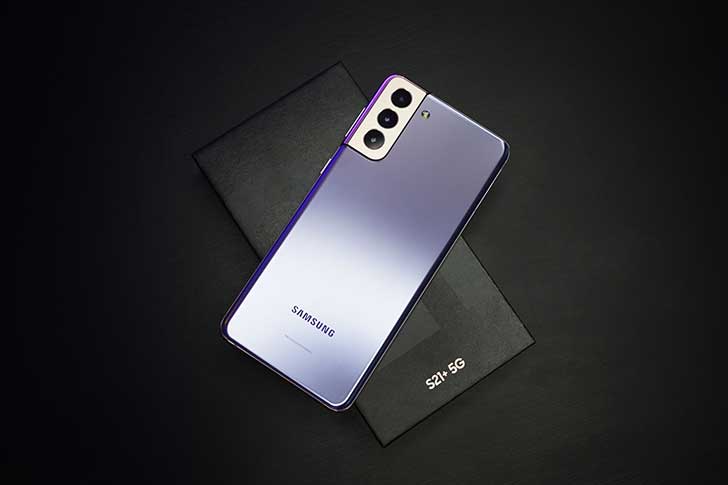
Samsung mission and vision statement
The mission of Samsung is “to devote its talent and technology to creating superior products and services that contribute to a better global society”. The vision statement of Samsung reads “to inspire the world with our innovative technologies, products, and design that enrich people's lives and contribute to social prosperity by creating a new future.”
Thus, the mission and vision of Samsung are aimed at enriching the lives of the people through the creation of superior products and services that contribute to social prosperity and a better global society (Mission, 2021).
Samsung industry analysis- Analysis of electronics goods industry
Electronic items have become an important part of the daily life of the customers which directly influences the growth and development of the electronic goods market. The electronic goods industry revenue was USD 1261165 Million in 2019 and the major players in the electronic markets include Sony, Apple, Philips, Samsung Electronics, LG Electronics, Canon, etc. (Wboc, 2021).
However, the outbreak of the COVID-19 pandemic negatively affected the demand for electronic items which caused a decline in the overall revenue of this industry. Further, a decline in the total exports due to the lockdown restrictions world over negatively impacted the sales of various products and services. However, the surge in the global demand for personal computers, laptops, and smartphones abated the negative impacts of COVID-19. Also, the global economy is in a recovery phase which is expected to have a positive influence on the demand for electronic goods. Further, the global smartphone market is expected to grow at a CAGR rate of 5.7% generating revenue of $ 512.1 billion in 2021 (EP&T, 2021)
Despite all this, China leads the global electronic industry due to inexpensive production and higher export of goods. Further, China’s production of various electronic goods items amounts to more than one-third of the total global consumer electronics production in the market. The top 10 consumer electronic goods exporter in the industry are shown as follows-
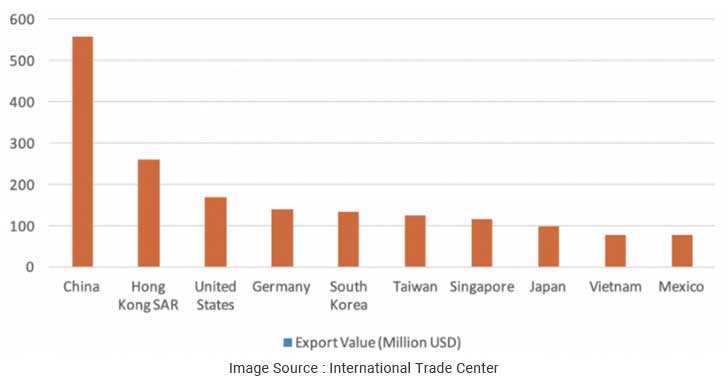
The figure shows that China, Hong Kong, and the United States are at the forefront of electronic goods production on a global scale. Further, various companies have shifted their manufacturing facilities to China due to the lower cost of production and effective supply chain network in China. Hence, the electronic goods industry is one of the fastest-growing industries in the global market, and increasing domestic demand for electronic goods in India and rising manufacturing cost in other manufacturing locations has contributed towards the growth of the electronic goods industry in the Indian market. The Global consumption of electronic goods in India is expected to double to 7% by the end of 2026. As a result of this, the Indian Cabinet minister has approved a $ 6.37 billion plan to boost up electronic manufacturing in India (Ficci, 2021). India is expected to become the next electronic manufacturing hub and the inspiration for this is twofold i.e. boosting exports for electronic items and making India manufacturing competitive in the Global electronic goods market (EKLAHARE, 2021).
Samsung core values
The core values of Samsung include people, integrity, change, co-prosperity, and excellence. Samsung dedicates itself to help citizens by offering the best quality products and services, maintaining responsible corporate citizenship, complying with ethical principles and legal standards, maintaining clean organizational culture, and respecting the customers (White, 2017). The major focus of the company is on caring for the environment as well as the health and safety of the customers as well as employees as a part of its corporate social responsibility.

Samsung external analysis
Samsung PESTEL analysis
PESTEL Analysis is an important environment analysis tool that helps to deeply evaluate the external market factors impacting the operations of the organization. The PESTEL analysis of Samsung is carried out as follows-
Political factors affecting Samsung
Samsung is a South Korean electronic goods company that has established its operations at an International scale. The export policies of South Korea play an important role in the overall success of the company. The main partner countries of South Korea include China, the US, Japan, Vietnam, and Hong Kong. However, the US-China war has placed unprecedented pressure on Seoul as the US-China war has increased the export and import of goods to the US and China (Lee, 2021). Despite this, South Korea has been caught between its ally as well as the top trading partner and the country is trying to achieve both. Furthermore, South Korea has bilateral trade agreements with India which is one of the positive factors for the growth of Samsung as India is expected to become the next manufacturing hub for electronic goods, and the bilateral trade relations between South Korea and India will have a positive impact on the overall growth of Samsung (Indembassy, 2021). However, Samsung heir, Lee Jae young is accused of the bribery scandal of the company and has been sentenced to jail for the period of 2 years and 6 months (Neate, 2021).
Economic factors affecting Samsung
The Global electronic goods industry is growing at the CAGR rate of 5.42 % and is expected to reach USD 1731053 Million in 2025. The technological proliferation, as well as the emergence of smart devices, are major factors that are contributing to the growth of the electronics and industry. In 2020, the global GDP amounted to USD 84.54 trillion which is expected to increase to USD 93.86 trillion in 2021 (Statista, 2021). The rising GDP rate of the economy shows recovery from the impacts of COVID-19 which further is expected to have a positive impact on the demand for electronic goods in the market.
China and the US are the major manufacturing hubs for electronic goods in the international market and the personal disposable income of the consumers in both countries will increase in 2021 which further will have a positive influence on the overall growth of the electronic goods industry. The disposable income of the United States has increased to 18048.10 USD Billion in 2021 and the personal disposable income of individuals in China was 17642 Yuan in the first quarter of 2021 which is 12.6% higher than the same period in the previous year.
Social factors affecting Samsung
The social environment is favorable for the growth of Samsung as the changes in the demographic profile of the customer, increasing population, the emergence of modern lifestyles, and increasing concern for high tech products has resulted in an increase in the demand for various electronic goods in the industry (Frost & Sullivan, 2021).
The customers in the current times are becoming more aware of the Hi-Tech products and demand convenient as well as high-quality products to meet their needs. The rising standard of living among the customers also has resulted in an increase in the demand for various electronic goods in the market. Increasing end-user demand and continuous technological innovation in the electronic goods industry have necessitated organizations to introduce new products in the market at a rapid pace. Furthermore, internet access and the use of Smartphones among customers have increased the trend of digital shopping. The customers shop various electronic goods over the digital channels which also require the electronic goods companies to use various online websites and digital channels to facilitate online shopping among the customers.
Technological factors affecting Samsung
Technological advancement has gained huge importance in the electronic goods industry and Samsung is one of the world's leading innovative electronic goods companies that drive innovation for bringing up sustainable business advantage. Display technology is an important innovation in the microelectronics industry that helps to improve image quality. The use of liquid crystal display technology also helps to form high-quality images for TV screens. In addition to this, innovation in wearable design is another important technological factor that is influencing the growth of the electronic goods industry. Furthermore, the use of various microelectronic devices is helping to develop new electronic goods such as LCD displays, encapsulation technologies, wireless charging systems, smart lighting, and other products. Electronic goods companies are also investing in these technologies to make innovative and creative products in the market (Sharpmeg, 2021).
Environmental factors affecting Samsung
To meet the growing need for electronic goods, various firms have invested in factories as well as production workshops to manufacture large quantities of electronic goods. However, increasing electronic goods production has resulted in increased environmental challenges. Furthermore, electronic goods also contain various toxic substances which have a negative impact on the environment. Along with this, people continue to change electronic goods year to year which requires proper recycling of the goods to prevent toxic chemicals released into air and water causing massive air and water pollution. Recycling electronic waste not only helps to conserve energy but also helps to recycle various natural resources such as aluminum, silver, and copper (Electronics, 2021).
Furthermore, electronic goods companies are also required to implement various environmental safety and prevention measures to reduce GHG emissions and improve environmental sustainability. The leading electronic goods company, Samsung has also implemented various environment protection strategies such as recycling measures, circular economy policy implementation, etc. to reduce GHG emissions and improve environmental sustainability.
Legal factors affecting Samsung
The electronic goods industry is tightly regulated due to the presence of various environmental and productivity regulations around the world that cost electronic goods companies substantially. Furthermore, electronic goods companies are also required to comply with the European Union restriction on the hazardous substances law which restricts the use of lead, mercury, cadmium, and other substances in the manufacturing of electronic goods (Carbone, 2013). Also, electronic goods companies are required to comply with various other laws such as the Pollution Prevention Act 1990, the National Environmental Policy Act 1969, Consumer Product Safety Act, etc. while manufacturing electronic equipment.
Samsung Porter five forces analysis
Porter five forces analysis is an important and analytical tool that is used to evaluate the five competitive forces that shape the industry. The Porter five forces analysis of the electronic goods industry is shown as follows-
Bargaining power of buyers of Samsung
The bargaining power of buyers in the electronic goods industry is high due to the low switching cost of the customer from one company to others and the presence of a large number of competitors in the industry. However, the size of buyers in the electrical goods industry is very small and the loss of one buyer does not cause much impact on the total revenue of the company.
Bargaining power of suppliers of Samsung
The bargaining power of suppliers in the industry is very low due to the presence of a large number of suppliers in the industry and low switching costs from one supplier to another. Furthermore, the company has supply chain relations with around 2500 suppliers around the world (Samsung, 2021). Samsung also produces memory chips, processors, and displays which help to reduce dependence on external suppliers.
Threat of substitute products to Samsung
The threat of substitute products of Samsung is high as various electronic goods such as smartphones can be substituted easily with ordinary mobile phones. The major competitors of Samsung include Sony, Apple, LG Electronics, etc. that causes a significant competitive threat to the company and low switching costs among the customers increase the threat of substitute products for Samsung. The threats that Samsung has from Apple Inc can be understood through the strategic evaluation of Apple Inc.
Threat of new entrants to Samsung
The threat of new entrants in the electronic goods industry is very low due to a number of reasons which include higher competitive threat, economies of scale of existing firms, strong brand image, and need for huge capital investment as well as skilled human resources. The legal and regulatory pressures in the industry also reduce the threat of new entrants in the electronic goods industry.
Competitive rivalry in the electronic goods industry
The competitive rivalry in the electronic goods industries is very large due to the similarity of the products in appearance as well as function and the presence of a large number of competitors in the industry. Moreover, large brands such as Apple, Sony, LG Electronics, Toshiba, etc. are competing for larger market shares in the industry, and technological innovation is one of the major differentiating factors that further increase the competitive rivalry among electronic goods companies.
Samsung competitor’s analysis
The main competitors of Samsung are Apple, LG Electronics, Lenovo Group, Sony, and Huawei Technologies. Apple is an American multinational technology company that is known for designing and selling various consumer electronics and computer software. LG Electronics also produces various electronic goods and home appliances such as radios, TVs, air conditioners, washing machines, and refrigerators. LG and Samsung are competing in the high-end TV market due to the effectiveness of the novel display Technology. LG also introduced a 173-inch micro LED TV in the International fair Association (YiningChen, 2018).
Furthermore, Sony also has attained a significant market share over the period of time that offers a diverse range of tech products such as gaming and network services, imaging and sensing solutions, electronic products, etc. The strong standing of Sony in the tech market gives strong competition to Samsung. Along with this, Huawei technologies is a Chinese multinational company that is known for manufacturing various smart devices as well as ICT-based products (Competitors, 2021). However, Huawei Technologies earns only half of the total revenue of Samsung. The revenue of Huawei technologies was only USD 136.7 billion in 2020 (Kharpal, 2021). In contrast to this, Samsung earned the revenue of USD 200 million in 2020 whereas the net sales of Apple were 274.5 to billion USD in 2020. Furthermore, the demand for smartphones is rising in the current time and Samsung leads in the smartphone market which is shown as follows-
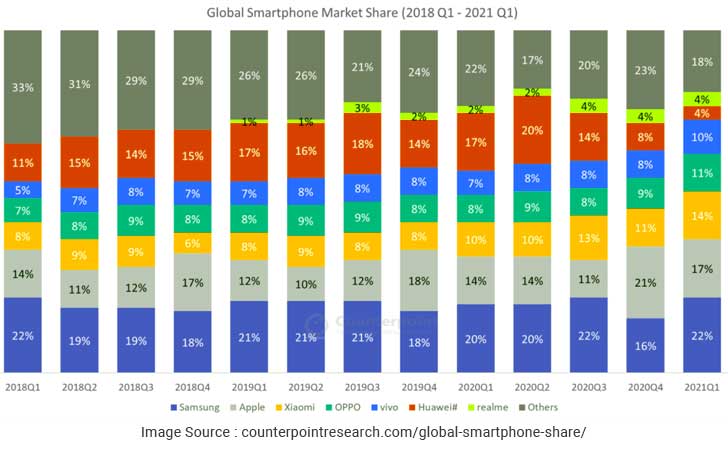
The above figure shows that Samsung is leading the smartphone market and the market share of Samsung in the smartphone market was 22 % as compared to 17 % of Apple and 14% of Xiaomi.
Samsung competitive strategy
The electronics goods industry involves aggressive competitive behavior where rapid technological innovation is adopted by the firm to ensure product differentiation. The generic competitive strategy of Samsung is a broad differentiation as Samsung offers unique products and services to the customers. Product development is another important strategy implemented by Samsung to achieve a competitive advantage in the consumer electronics market. Furthermore, the product development strategy of Samsung is in line with the mission and vision of Samsung which focuses on product superiority and delivery of high-quality services to the customers. Samsung also chooses to invest heavily in research and development activities to support innovation and product development (Tringali, 2021). The other major competitive strategy of Samsung is the Red Ocean Strategy in accordance with which the company ventures into the existing markets by building on the weaknesses of the competitor firms to establish strong competition in the industry. Also, the company flooded the market with many products to ensure customer satisfaction as well as indulging brand imaging.
Samsung positioning analysis
Samsung is positioned as an innovative and unique brand that offers high-class design products to customers through the use of cutting-edge technology. Furthermore, the price charged by Samsung for its products is very low when compared to the prices charged by the competitor firm, especially Apple. Also, the low cost pricing strategy of Samsung helps to achieve a strong competitive position in the industry. Along with this, Samsung also outpaces the competitor firms in the terms of product portfolio and variety.
Samsung internal analysis
Samsung VRIO analysis
VRIO analysis is an important strategic analysis tool that helps to evaluate the resources and capabilities of the organization. The VRIO analysis of Samsung is as follows-
| Resources and capabilities | Valuable | Rare | Inimitable | Organized | Competitive advantage |
|---|---|---|---|---|---|
| Financial resources | Yes | Yes | Yes | Yes | Long term competitive advantage |
| Customer loyalty | Yes | No | No | Yes | Competitive parity |
| Production facilities | Yes | Yes | Yes | Yes | Strong competitive advantage |
| Innovation | Yes | Yes | Yes | Yes | Strong competitive advantage |
| Product portfolio | Yes | Yes | Yes | Yes | Strong competitive advantage |
| Technological advancement | Yes | Yes | No | No | Temporary competitive advantage |
| Production challenges | Yes | No | No | No | Competitive parity |
| Human resource management | Yes | No | No | No | Competitive parity |
| Samsung designs | Yes | Yes | Yes | Yes | Strong competitive advantage |
| Management philosophy | Yes | Yes | Yes | No | Unused competitive advantage |
| Research and development | Yes | Yes | Yes | No | Unused competitive advantage |
| Intellectual property | Yes | Yes | Yes | Yes | Strong competitive advantage |
| Pricing strategies | Yes | No | No | No | Competitive parity |
| Channel management | Yes | Yes | Yes | Yes | Strong competitive advantage |
Samsung Non-Core Competencies and Competitive Disadvantage
The non-core competencies of Samsung include production challenges, lack of customer loyalty, and ineffective HRM management. Samsung relied heavily on the American market which shows the market penetration strategy being adopted by Samsung to achieve higher sales. Further, the company also suffered product failures due to faulty products being launched to the market which threatened the overall reputation of the company. The Samsung Galaxy A20 is one of the faulty foldable phones launched in the market that has resulted in a decline in the overall trust and confidence of the customers in the company (Designboom, 2021). The bribery scandal of the company also depicted the unethical practices of the company which has tainted the reputation of the company. Not just this, the brand loyalty of Samsung is very low when compared with the brand loyalty of Apple. The brand value of Samsung has declined from 85.7 % to 74% between 2019 and 2021. Also, the brand loyalty of Apple has remained high all the time which is 92 % in 2021 as compared to 19.5% in 2019 (Mahipal, 2021). Along with this, the Note 7 debacle was launched to the market without independent testing which resulted in various problems for the customers. The manufacturing defect in this product also increased the risk of short-circuiting as well as combustion (Minter, 2016). In addition to this Samsung also faces various HRM challenges, mainly recruitment challenges which also raises several quality issues and production challenges for the company.
Samsung core competencies, resources and capabilities
The core competencies of Samsung include technological advancement, innovation, research and development, financial effectiveness, production facilities, strong product portfolio, and intellectual property rights. Samsung has hired multicultural employees at its workplace and globalization plays an important role in this aspect as rising globalization has necessitated the need for the company to hire employees from different cultural backgrounds to improve organizational effectiveness. The current management philosophy of the company to drive innovation and technological advancement for delivering superior products to the customers also helps to achieve a strong competitive position in the industry. The intellectual property rights of the company are an integral part of the research and development processes and the company currently holds around 197,749 Intellectual Property Rights around the world. The number of patents registered in each country is shown as follows-

The patent rights held by Samsung are mainly related to the smartphone, smart TVs, system LSI products, and memory cards. Along with this, a strong product portfolio also helps the company to achieve a strong market position. The overall revenue of the company across different divisions and products is shown as follows-

The above figure depicts that the strong product portfolio of Samsung helps to achieve a strong market position in the industry. The company also has established its production as well as operational facilities in different countries. The Overseas operations of Samsung include operations in Europe, China, and North America with a total of nine regional headquarters under IM and CE divisions. Along with this, Samsung also invests a hefty sum of money in research and development activities to bring out creative and innovative products in the market. The total investment of Samsung in various research and development activities is shown as follows-

The above figure shows that Samsung is investing huge sums of money in research and development to bring out new products and services in the market and to meet its mission of delivering superior quality products to the customers.
Samsung SWOT analysis
SWOT analysis helps to determine the current as well as the future position of the company through analysis of the strengths, weaknesses, opportunities, and threats for the company. The SWOT analysis of Samsung is performed as follows-
| Strengths of Samsung | Weaknesses of Samsung |
|---|---|
|
|
| Opportunities to Samsung | Threats to Samsung |
|
|
Samsung business strategy analysis
The business strategy of Samsung is associated with a higher degree of flexibility as Samsung continues to adopt diverse strategies according to the change in the external market. Further, new product development is an important strategy of the company that helps to achieve a strong competitive position in the market. Samsung launched black and white TV but since then, the continuous launch of new products in the industry has made Samsung one of the leading electronic goods companies in the market. Furthermore, the extensive product range of Samsung includes device solutions, IT and mobile communication, and consumer electronics. Further, the company also has implemented the standardization strategy to further ensure higher customer satisfaction. The standardization strategy also helps Samsung to achieve higher economies of scale in the industry. Along with this, vertical integration is another important strategy of Samsung which helps the company to effectively compete with Apple as vertical integration helps the company to leverage all aspects of the manufacturing process from the raw material integration to the assembly of the products. The business-level strategies of Samsung include superior product innovation, customer responsiveness, high-quality products, differentiation, and technological advancement (Hanoi, 2013).
Samsung business model
The business model of Samsung is based on vertical integration which provides a chief competitive advantage to Samsung. Vertical integration helps the company to ramp up the production of its goods in different markets. In addition to this, the business model of the company is based on different strategies which include risk-taking, diversification, cost advantage, and technological advancement (Bhasin, 2021).
Samsung business canvas model
The business model canvas of Samsung is shown as follows-
| Key partners | Key activities | Value propositions | Customer relationships | Customer segments |
|---|---|---|---|---|
| Joint venture companies (Toshiba, Sony, GE) Sponsorships Investors Component manufacturers Suppliers Conglomerates (heavy industries, financial services, electronics) Affiliated companies Telecom companies Acquisitions | Research and development Manufacturing Advertising Distribution Consultation Marketing New product development Quality control Logistics Repair services Financial services | Cutting edge technology Innovative products Green designs Product functionality Superior products and services Affordable products | Customer loyalty Community Online delivery services Customer experience Loyalty Expertise Expertise Know-how Personal assistance | Mass market Tech-adopters |
| Key resources | Channels | |||
| Brand image Intellectual property Excellence Product diversity | Press TV Stores Global sales and support teams Samsung community Events Press Samsung website Distribution channels Third parties | |||
| Cost structure | Revenue streams | |||
| Cost of raw material Distribution and logistics IP protection Service development Economies of scale product development HRM cost Advertising and marketing Quality control IT cost Manufacturing cost Economies of scale | Sale of electronic goods Sale of goods to third parties Service fees Licensing Manufacturing fees | |||
Samsung marketing analysis

The marketing analysis involves the study of the market dynamism and strategies implemented by the organization to achieve a strong competitive position in the industry. The marketing analysis of Samsung is performed as follows-
Samsung Marketing mix
The marketing plan refers to the operational plan that outlines the marketing strategies of the company. The marketing mix of Samsung is discussed as follows-
Samsung Products
The key strategy adopted by Samsung is product diversification and product development. Samsung also invests huge sums of money in research and development practices to deliver superior products to the customers. The major products offered by the company include mobile devices, TV, information technology, memory cards, USB flash drives, Samsung home appliances, printers, monitors, etc. along with this, smartphones have achieved a leading position in the global electronics and gadgets market due to frequent launch of new mobile phones. The Television product line of Samsung includes 4K ultra HD, Curved LED TVs, and smart TVs (Share Broadnax, 2021).
Pricing strategy of Samsung
Samsung Group uses various pricing strategies and price skimming is an important strategy that is implemented by Samsung while launching the new product in the market to attract higher value and profitability. Further, Samsung launched Samsung Note 3 + Gear through a price skimming strategy to further achieve huge profits. The company also implemented a competitive pricing strategy for products other than the smartphones such as televisions, refrigerators, hair conditioners, etc. The main aim behind the competitive pricing strategies is to establish a strong competitive position and attract a number of consumers in the market. The company also uses the penetrative pricing strategy to maintain a strong customer base in the market.
Place/ distribution of Samsung
Samsung sells its products to the customers through various channels which include retailers, distributors, online websites, etc. Furthermore, Samsung has its products available across 180000 retail outlets in India (THAKUR & SEN, 2018). Along with this Samsung also has tie-ups with various small and large retail Giants such as Reliance Digital, Chroma, Vijay Sales, etc. that helps to facilitate fast delivery of the goods to the customers. Along with this, E-Commerce channels such as Amazon and Facebook are also utilized by Samsung to sell them to customers. The distribution channels of the company in the domestic and international markets are shown as follows-
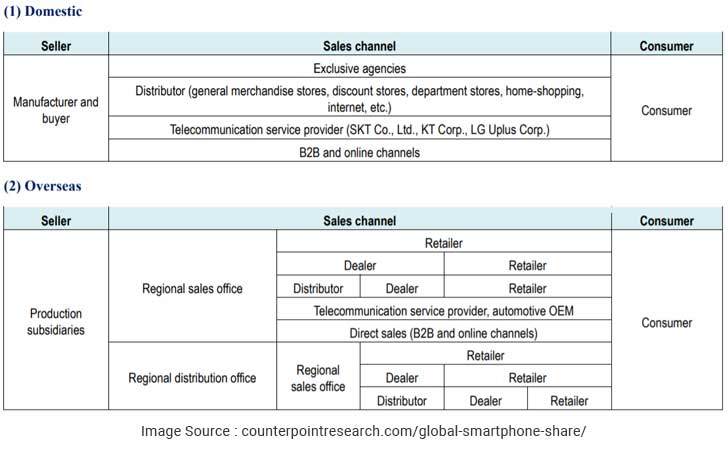
Promotional strategies of Samsung
Samsung uses various promotional strategies to pull the customers towards its product. The company also uses sales promotional strategies to push the customers towards its product. Also, various discounts are offered to the customers which also helps to motivate them to purchase the Samsung product. In addition to this, the company promotes the new products to use various traditional advertising strategies such as newspapers, magazines, etc. The use of digital media strategies also helps the company to attract a number of customers to its products. The company also has a huge number of followers on its social media channels which also helps to promote the product among the customers. The positive reviews of the customers on various social media sites also help to influence the Purchase Decision of the number of customers. Along with this, the company also places large posters on the highways to raise customer awareness.
Social media marketing analysis
All businesses are now leveraging the advantages of social media to enhance their outreach and brand engagement. Social media marketing strategy is one of the important marketing strategies that is adopted by Samsung to raise brand awareness and to attract a number of customers. The company has a total of 330 social media profiles which are shown as follows-
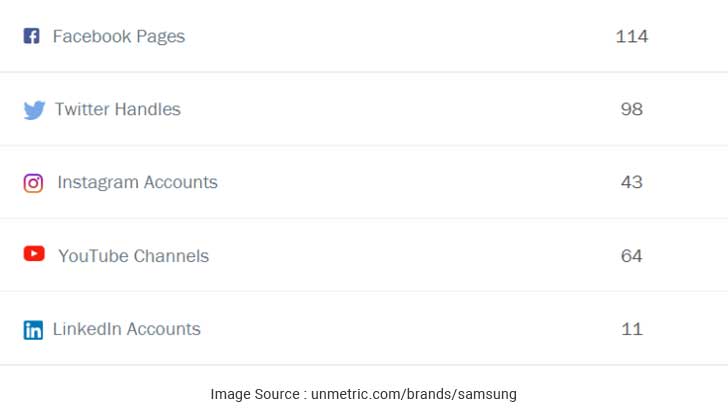
The above figure shows that Samsung has a number of social media accounts to raise customer engagement. Further, the following figure analyses the social media performance of Samsung-

The above figure shows that Samsung has 1,270,515 followers on its Facebook page. Further, the overall engagement rate of the customers on the Instagram profile is 220 and the number of customer likes for various Samsung products is 5333 with total comments equal to 151. Samsung also receives replies and retweets from customers over its Twitter account and there are around 176 tweets. Furthermore, Samsung has spent $10 million on Facebook ads in the three-week period and the Samsung USA Facebook ad campaign also has reached 105 million people (Ryancohn, 2021).
Samsung STP analysis
STP analysis is an important consumer analysis tool that helps to identify the target market as well as the position of the company. The STP analyses of Samsung for different product categories is performed as follows-
Samsung segmentation
The market segmentation of Samsung on the basis of different customer groups is shown as follows-
| Type of segmentation | Segmentation criteria | Samsung device solutions | Samsung consumer electronics | Samsung mobile and IT solutions |
|---|---|---|---|---|
| Geographic segmentation | Region | Global | Global | Global |
| Density | Rural and urban | Rural and urban | Rural and urban | |
| Demographic | Gender | Both male and female | Both male and female | Both male and female |
| Age | Above 25 years | Above 18 years | Above 18 years | |
| Occupation | Executives, professionals | Students, employees, executives, professionals | Students, employees, executives, professionals | |
| Behavioral factors | Loyalty | High, medium, low, switchers | High, medium, low, switchers | High, medium, low, switchers |
| Benefits sought | User-friendliness, advanced functionality, high quality, and simplicity | User-friendliness, advanced functionality, high quality, and simplicity | User-friendliness, advanced functionality, high quality, and simplicity | User-friendliness, advanced functionality, high quality, and simplicity |
| Personality | Ambitious | Easy going, cost-conscious and ambitious | Determined and ambitious | |
| User status | Non-user, first time user, regular user, potential users | Non-user, first time user, regular user, potential users | Non-user, first time user, regular user, potential users | |
| Psychographic | Social class | Working-class, Middle to upper class | Middle to upper class | Middle to upper class |
Samsung Targeting
The target market of Samsung is very wide-ranging from the day-to-day usage devices to the industrial standard device solutions. The usual target market of the company includes customers above the age of 18 years. Further, due to the competitive pricing strategy and penetration pricing strategy, the company mainly focuses on customers from medium to high-income groups. However, the company also targets ambitious and stylish people through its skimming pricing strategies adopted for the launch of new products in the market.
Samsung Positioning
Samsung is positioned as the most innovative and technologically advanced company that produces the best as well as superior quality products for its customers. Samsung is also recognized as an affordable brand by the customers as the company charges low prices for its product as compared to the price of the other brands such as Apple. Furthermore, the company has adopted customer-focused strategies which help to create a strong brand image in the market. The positioning map of the company is shown as follows-
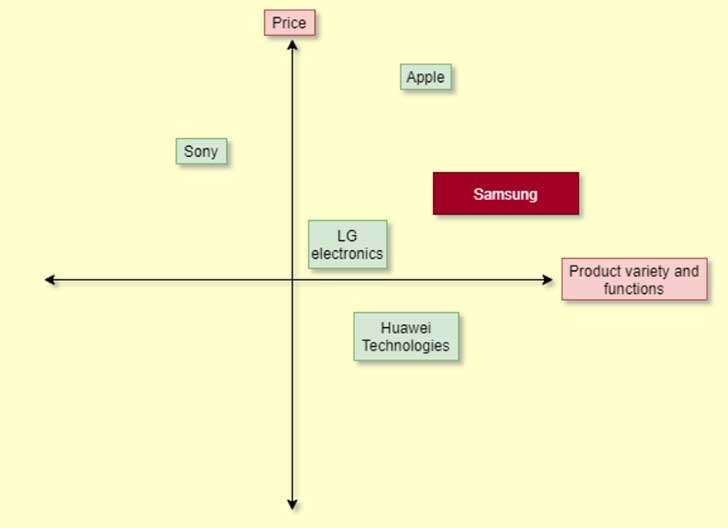
Samsung Consumer analysis
The target customers of Samsung include customers about the age of 18 years. Further, the number of shipments of Samsung smartphones in the global market is shown in the below illustration.

The above figure shows that the shipments of Samsung smartphones have increased over the period time and the rising number of shipments has helped Samsung achieve a leading position among the top 3 smartphone vendors in the world. Along with this, the brand loyalty of Samsung has achieved the highest jump in the market as depicted below.
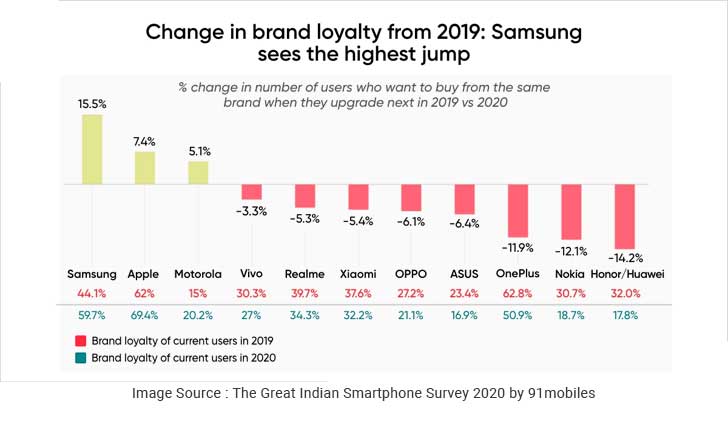
The above figure depicts that Samsung has seen the highest jump in brand loyalty from 2019 to 2020 and is expected to achieve a leading position in terms of customer brand loyalty in the coming times. This is due to the high-quality products and services of Samsung as well as continuous innovation in the market.
Recommendations for Samsung
Strategic analysis of Samsung helped to determine that innovation and technological advancement is one of the major factors that present a competitive advantage for Samsung in the market. However, it is found that the company is facing the issue of product failures in the current times. Thus, various strategies for Samsung are recommended as follows-
- Samsung should invest in initial testing procedures to prevent the issue of product failures and to improve the overall quality of its products.
- An effective code of conduct for all the employees in the organization should be implemented to prevent the issues of corruption, bribery, and unethical practices.
- Samsung should continue to invest in innovative strategies to ensure higher business growth and a bigger market share in the market. Innovation strategies will also help ensure higher customer satisfaction in the market.
- Samsung should come up with more innovative television and display technologies to raise its brand image in the market. Along with this, Samsung should also invest in wearable technology to achieve a significant market share in the wearable market.
- Samsung should also lower its prices of Smartphones to compete with various small competitive firms such as Xiaomi and Huawei Technologies.
- Rising political challenges such as the US-China war also necessitated Samsung to improve its supply chain practices and reduce its dependence on the United States and China. India is expected to become the next manufacturing hub for electronic goods. Hence, Samsung should also invest in Indian manufacturing locations to further improve its supply chain effectiveness.
- Samsung should look to foster higher employee engagement among its employees for better outcomes and higher prospects of further advancement.
Conclusion
The strategic analysis of Samsung shows that Samsung has achieved a leading position in the global smartphone industry. However, it is found that Samsung is facing product failure in the market which has caused a decline in customer satisfaction and brand loyalty for Samsung. Hence, it is recommended that the initial testing procedure should be implemented by Samsung to improve its brand image in the market and to build customer loyalty. Also, Samsung should come up with more innovative Technologies to further ensure higher business growth and market share in the industry.
References
- Bhasin, H. (2021). Business Model of Samsung - How does Samsung make money?. Marketing91. Retrieved 7 September 2021, from https://www.marketing91.com/business-model-of-samsung/.
- Carbone, J. (2013). Electronics industry faces a growing regulatory environment. Sourcetoday.com. Retrieved 6 September 2021, from https://www.sourcetoday.com/supply-chain/article/21866085/electronics-industry-faces-growing-regulatory-environment.
- Competitors. (2021). Top 10 Samsung Competitors In 2021 - What Competitors. What Competitors. Retrieved 6 September 2021, from https://whatcompetitors.com/samsung/.
- Designboom. (2021). Samsung has reportedly fixed its faulty $2,000 folding phone. designboom | architecture & design magazine. Retrieved 7 September 2021, from https://www.designboom.com/technology/samsung-foldable-phone-galaxy-fold-breaking-after-a-couple-of-days-04-18-2019/.
- EKLAHARE, J. (2021). India on its way to become the next electronics manufacturing hub?. https://www.industr.com. Retrieved 6 September 2021, from https://www.industr.com/en/india-on-its-way-to-become-the-next-electronics-manufacturing-hub-2598367.
- Electronics. (2021). How Does Recycling Electronics Help the Environment | Blog. Great Lakes Electronics. Retrieved 6 September 2021, from https://www.ewaste1.com/how-does-recycling-electronics-help-the-environment/.
- EP&T. (2021). Growth anticipated for global consumer electronics revenues - Electronic Products & Technology. Electronic Products & Technology. Retrieved 6 September 2021, from https://www.ept.ca/2021/03/growth-anticipated-for-global-consumer-electronics-revenues/.
- Ficci. (2021). India to become an Electronic Manufacturing Hub,CXOToday,Mar 23, 2020. ficci.in. Retrieved 6 September 2021, from https://ficci.in/ficci-in-news-page.asp?nid=20821.
- Frost, & Sullivan. (2021). Growing Demand For Consumer Electronics Driving The Outsourcing Trend In The Electronics Industry. Healthitoutcomes.com. Retrieved 6 September 2021, from https://www.healthitoutcomes.com/doc/growing-demand-for-consumer-electronics-drivi-0001.
- Hanoi. (2013). SAMSUNG Strategies Analysis Report. Docshare01.docshare.tips. Retrieved 7 September 2021, from http://docshare01.docshare.tips/files/28044/280449607.pdf.
- Indembassy. (2021). Embassy of India, Seoul, Republic of Korea : India - RoK Trade and Economic Relations. Indembassy Seoul.gov.in. Retrieved 6 September 2021, from https://www.indembassyseoul.gov.in/page/india-rok-trade-and-economic-relations/#:~:text=1.,mark%20for%20the%20first%20time.&text=Korea's%20total%20FDI%20to%20India,2020%20stands%20at%20%246.94%20billion.
- Kharpal, A. (2021). Huawei’s growth slowed dramatically in 2020 as U.S. sanctions took their toll. cnbc. Retrieved 6 September 2021, from https://www.cnbc.com/2021/03/31/huawei-2020-revenue-growth-slows-dramatically-as-us-sanctions-hit.html.
- Lee, C. (2021). South Korea Is Caught Between China and the United States. Carnegie Endowment for International Peace. Retrieved 6 September 2021, from https://carnegieendowment.org/2020/10/21/south-korea-is-caught-between-china-and-united-states-pub-83019.
- Mahipal, A. (2021). Report: Brand loyalty at an all-time high of 92% for Apple as Android brands take a dive - SellCell.com Blog. SellCell.com Blog. Retrieved 7 September 2021, from https://www.sellcell.com/blog/cell-phone-brand-loyalty-2021/.
- Minter, A. (2016). Samsung’s Biggest Problem? Its Phones Can’t Be Fixed. IndustryWeek. Retrieved 7 September 2021, from https://www.industryweek.com/leadership/corporate-responsibility/article/21986445/samsungs-biggest-problem-its-phones-cant-be-fixed.
- Mission. (2021). Samsung Mission Statement 2021 | Samsung Mission & Vision Analysis. Mission-statement.com. Retrieved 6 September 2021, from https://mission-statement.com/samsung/#:~:text=Samsung's%20mission%20statement%20is%20%E2%80%9Cto,upgrades%20life%20itself%20with%20its.
- Neate, R. (2021). Samsung boss to be freed from jail after bribery sentence. The Guardian. Retrieved 6 September 2021, from https://www.theguardian.com/technology/2021/aug/09/samsung-boss-to-be-freed-from-jail-after-bribery-sentence.
- News. (2021). Sustainable Practices: Samsung’s Eco-Conscious Efforts Towards a Better Tomorrow. News.samsung.com. Retrieved 7 September 2021, from https://news.samsung.com/global/sustainable-practices-samsungs-eco-friendly-efforts-towards-a-better-tomorrow.
- Ryancohn. (2021). How Samsung Turned $10M in Ads into $129M in Sales - Sachs Media. Sachs Media. Retrieved 7 September 2021, from https://sachsmedia.com/how-samsung-turned-10m-in-ads-into-129m-in-sales/.
- Samsung. (2021). Sustainable Supply Chain | Environment | Sustainability | Samsung US. Samsung Electronics America. Retrieved 6 September 2021, from https://www.samsung.com/us/aboutsamsung/sustainability/environment/sustainable-supply-chain/.
- Share Broadnax. (2021). Product Mix: Samsung. Product Analysis. Retrieved 7 September 2021, from https://sharebasproductanalysis.wordpress.com/2018/09/21/product-mix-samsung/.
- Sharp Meg. (2021). How This Technology Is Changing The Electronics Industry – Sharp MEG. Sharpmeg.com. Retrieved 6 September 2021, from https://www.sharpmeg.com/technology-is-changing.
- Statista. (2021). Global GDP 2014-2024 | Statista. Statista. Retrieved 6 September 2021, from https://www.statista.com/statistics/268750/global-gross-domestic-product-gdp/.
- THAKUR, A., & SEN, A. (2018). Samsung India: The bigger picture. Fortuneindia.com. Retrieved 7 September 2021, from https://www.fortuneindia.com/enterprise/samsung-india-the-bigger-picture/102822.
- Tringali, S. (2021). How Samsung's Marketing Strategy Transformed Them Into A Global Brand — Proecho Solutions | Asheville Marketing Agency. Proecho Solutions | Asheville Marketing Agency. Retrieved 6 September 2021, from https://proechosolutions.com/asheville-marketing/how-samsungs-marketing-strategy-turned-them-into-a-technological-powerhouse.
- Wboc. (2021). Global Electronics Market Growing at CAGR of 5.42% and Expected to Reach USD 1731053 Million During Forecast Period (2021-2025). Wboc.com. Retrieved 9 September 2021, from https://www.wboc.com/story/44124393/global-electronics-market-growing-at-cagr-of-542-and-expected-to-reach-usd-1731053-million-during-forecast-period-2021-2025.
- White, S. (2017). How core values shape these 5 tech giants. CIO. Retrieved 6 September 2021, from https://www.cio.com/article/3157694/how-core-values-shape-these-5-tech-giants.html
- YiningChen. (2018). LG and Samsung Continue Their Competition in the Display Industry. Ledinside.com. Retrieved 6 September 2021, from https://www.ledinside.com/news/2018/11/lg_and_samsung_continue_their_competition_in_the_display_industry.
